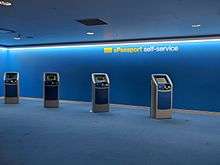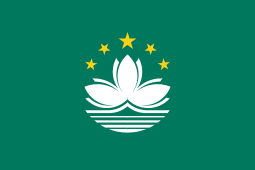SmartGate
| SmartGate | |
|---|---|
 | |
 SmartGate for arrivals at Sydney Airport, Australia | |
| Type of project | Electronic border control system |
| Country | Australia and New Zealand |
| Launched |
2007 [1] Brisbane Airport[2] |
| Budget |
Capital cost: NZD $15.9m Operational cost: NZD $7.4m[3] |
| Status: Active | |
SmartGate is an electronic border control system introduced in 2007 developed by the Australian Border Force. The service was introduced to facilitate faster and more secure travel between countries by performing passport control checks electronically.[4]
Travellers require a biometric passport to use the service as it uses information from the passport (such as photograph, name and date of birth) and in the respective countries' databases (i.e. banned travellers database) to decide whether to grant entry / departure from the country or to generate a referral to a customs agent.[5] These checks would otherwise require manual processing by a human which is time-consuming, costly and potentially error-prone.[3]
History
Originally launched at Brisbane Airport, SmartGate is now available for use at most international airports across Australia and New Zealand.
2002
First trial of SmartGate begins with Qantas aircrew.[6]
2004
Trials expanded from use with Qantas aircrew to include over 1,000 Qantas platinum frequent flyers.
2007
Introduced to the public at Brisbane Airport.[4]
2009
New Zealand Prime Minister John Key, as part of an official visit to Australia, struck an agreement between himself and Australian Prime Minister Kevin Rudd to allow Trans-Tasman travellers to "transit through the entire [customs] process within eight minutes"[7] to further free up the already liberal travel arrangements between the two nations.
Eligibility
Travellers are still required to make arrangements for a valid visa and to complete an arrival / departure card in order to comply with travel requirements. In order for the system to be process travellers, they are advised to look as much like their passport photo as possible. This means removing any glasses or hats when using SmartGate.
Australia
Requirements
Departing travellers, regardless of age and nationality, can use SmartGate so long as they have a machine-readable passport and can independently use the machine.

Arriving travellers using SmartGate must:[8]
- hold a valid and current biometric passport and;
- be over the age of 16 and;
- hold a passport from one of the following issuing countries:
-
 Australia
Australia -
 Canada
Canada -
 China
China -
 France
France -
 Hong Kong
Hong Kong -
 Ireland
Ireland -
 Japan
Japan -
 Korea
Korea -
 Macau
Macau -
 New Zealand
New Zealand -
 Singapore
Singapore -
 Sweden
Sweden -
 Switzerland
Switzerland -
 United Arab Emirates[9]
United Arab Emirates[9] -
 United Kingdom
United Kingdom -
 United States of America
United States of America
-
Exceptions
There are a number of notable exceptions when entering and departing Australia and using SmartGate.[8]
- If airline crew meet the above requirements they are also eligible to use SmartGate or they may continue to use the "crew lane".[8]
- Australian and New Zealand citizens travelling on military orders may not use SmartGate upon arrival.[8]
- Australian children aged 10 to 15 years (inclusive) can use SmartGate upon arrival if they are accompanied by at least two adults.[8]
Locations
In Australia SmartGate is available at all major international airports, including:
- Adelaide
- Brisbane
- Cairns
- Canberra
- Darwin
- Gold Coast
- Melbourne
- Perth
- Sydney
New Zealand
Requirements
Arriving travellers using SmartGate must:[10]
- hold a valid and current biometric passport and;
- be over the age of 12 and;
- hold a passport from one of the following issuing countries:
Locations
In New Zealand SmartGate is available at all major international airports (with the exception of Dunedin), including:
- Auckland
- Christchurch
- Queenstown
- Wellington
Privacy
The personal information collected by SmartGate includes the information on the biometric page of the passport, such as:[8]
- name
- gender
- date of birth
- passport number
- passport photograph
- nationality
- the country of origin of the passport
Other information may also be collected and collated, such as:[8]
- travel details
- the facial biometric template
Travellers passports are no longer stamped if they are processed by SmartGate.
References
- ↑ "PM - Biometric 'Smartgate' system to be introduced to Australian airports". www.abc.net.au. Retrieved 2017-01-15.
- ↑ "Australian SmartGate trial extended to Singaporean e-passport holders". Future Travel Experience. 2014-03-20. Retrieved 2017-01-15.
- 1 2 "Part 5: Processing passengers faster at airports — Office of the Auditor-General New Zealand". www.oag.govt.nz. Retrieved 2017-01-15.
- 1 2 "New SmartGate aims to decrease airport queues". Retrieved 2017-01-15.
- ↑ "New Zealand Customs Service : How does SmartGate work?". www.customs.govt.nz. Retrieved 2017-01-15.
- ↑ "Roger Clarke's 'SmartGate'". www.rogerclarke.com. Retrieved 2017-01-15.
- ↑ "Eight minutes to clear customs". One News. 20 August 2009. Retrieved 12 November 2011.
- 1 2 3 4 5 6 7 "Arrivals SmartGate". www.border.gov.au. Retrieved 2017-01-15.
- ↑ UAE nationals can use SmartGate at Australian airports
- ↑ "New Zealand Customs Service : Who can use SmartGate?". www.customs.govt.nz. Retrieved 2017-01-15.